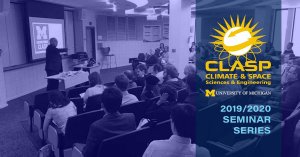Presented By: Climate and Space Sciences and Engineering
CLASP Seminar Series: Dr. Seth Claudepierre

Dr. Seth Claudepierre of UCLA will give a lecture as part of the CLASP Seminar Series.
Please join us!
Title: "What's up (and down) in the Earth's Van Allen radiation belts?"
Abstract: The high-energy tail of the plasma in near-Earth space is trapped by the geomagnetic field, forming the Van Allen radiation belts that encircle the Earth. Various physical processes can rapidly accelerate these charged particles to prodigious energies, in excess of one megaelectron volt, on timescales of one day or less. Owing to the hazard that this radiation poses to manmade technologies in space, there is considerable interest in understanding the processes that govern the particle dynamics. To that end, NASA launched the twin Van Allen Probes in 2012 to improve radiation belt predictability, and radiation belt science has evolved significantly over that time. With the recent conclusion of the mission, it is time to survey the landscape to take stock of where we have been, and where we are going. We will thus present an overview of recent advances in radiation belt science, highlighting current research trends and several unresolved issues, with an emphasis on what has been revealed in the Van Allen Probes observations.
Please join us!
Title: "What's up (and down) in the Earth's Van Allen radiation belts?"
Abstract: The high-energy tail of the plasma in near-Earth space is trapped by the geomagnetic field, forming the Van Allen radiation belts that encircle the Earth. Various physical processes can rapidly accelerate these charged particles to prodigious energies, in excess of one megaelectron volt, on timescales of one day or less. Owing to the hazard that this radiation poses to manmade technologies in space, there is considerable interest in understanding the processes that govern the particle dynamics. To that end, NASA launched the twin Van Allen Probes in 2012 to improve radiation belt predictability, and radiation belt science has evolved significantly over that time. With the recent conclusion of the mission, it is time to survey the landscape to take stock of where we have been, and where we are going. We will thus present an overview of recent advances in radiation belt science, highlighting current research trends and several unresolved issues, with an emphasis on what has been revealed in the Van Allen Probes observations.